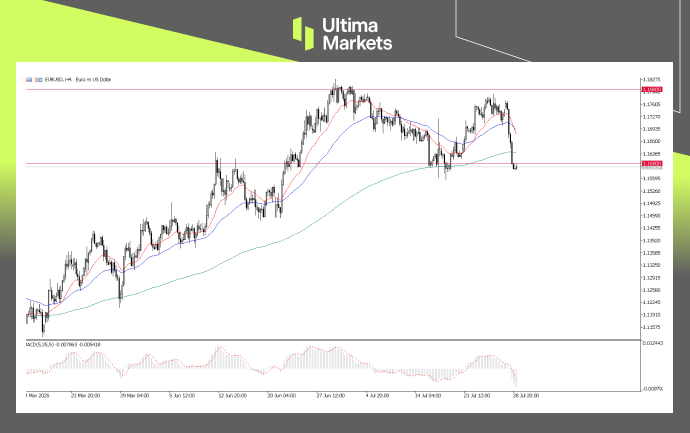Euro Slides as Trade Deal Faces Backlash
Despite reaching a trade agreement with the U.S., the euro fell sharply—down 1.3% after initial gains, as European officials criticized the deal for heavily favoring the U.S. France called it a “dark day” for the EU, while the euro-area growth outlook deteriorated further.
As a result, the U.S. Dollar Index surged to 98.50, while the British pound slipped toward a two-month low.
Mixed Sentiment in Europe
European equities and the euro weakened in the wake of the U.S.–EU trade agreement. While the deal avoided a major tariff escalation, investor confidence wavered due to concerns over growth headwinds and an increasingly unequal trade balance.
“This can be seen as a win for the U.S., as the tariff threat helped them secure key advantages—ultimately causing a drop in market confidence across the eurozone,” said Shawn Lee, Senior Analyst at Ultima Market.
On Monday, broad European indices declined, with the EuroStoxx50 (EU50) falling more than 1%, while the UK FTSE 100 snapped its eight-day winning streak amid cautious risk sentiment.
In contrast, U.S. markets continued their bullish momentum, with the S&P 500 and Nasdaq posting record closes for the sixth consecutive session. The rally was fueled by renewed trade optimism and robust tech earnings, with Tesla, Alphabet, and Nvidia leading gains across sectors.
EURUSD: Faces Backslash on Trade Deal
The euro initially rebounded last week from key support near 1.1600, climbing toward 1.1750 following the announcement of the U.S.–EU trade agreement. However, momentum quickly faded as political backlash intensified and eurozone growth concerns resurfaced. The move may also reflect a classic “sell-the-news” reaction.

EUR/USD, 4-Hour Chart Analysis | Source: Ultima Market MT5
From technical perspective, resistance remains firm near the 1.1780 – 1.1800, which aligns the consolidation zone. Support is now eyes at the 1.1600, where price previously found footing. If 1.1600 fails to hold, this could suggest a potential for deeper pullback.
The pair is likely to remain under pressure unless market sentiment toward Europe improves or the U.S. Dollar weakens materially.
What’s on the Deck
Looking ahead, market attention is turning toward two key developments that could shape near-term direction. The first is the resumption of U.S.–China trade negotiations in Stockholm, where both sides are working to extend the current tariff truce before the August 12 deadline.
The second major event is the U.S. Federal Reserve’s policy meeting on July 29–30. While the Fed is expected to hold interest rates steady, Chair Jerome Powell’s press conference will be closely watched for signals on the central bank’s outlook for inflation, labor market trends, and any potential shifts in monetary policy.
Disclaimer
Comments, news, research, analysis, price, and all information contained in the article only serve as general information for readers and do not suggest any advice. Ultima Markets has taken reasonable measures to provide up-to-date information, but cannot guarantee accuracy, and may modify without notice. Ultima Markets will not be responsible for any loss incurred due to the application of the information provided.
Why Trade Metals & Commodities with Ultima Markets?
Ultima Markets provides the foremost competitive cost and exchange environment for prevalent commodities worldwide.
Start TradingMonitoring the market on the go
Markets are susceptible to changes in supply and demand
Attractive to investors only interested in price speculation
Deep and diverse liquidity with no hidden fees
No dealing desk and no requotes
Fast execution via Equinix NY4 server









